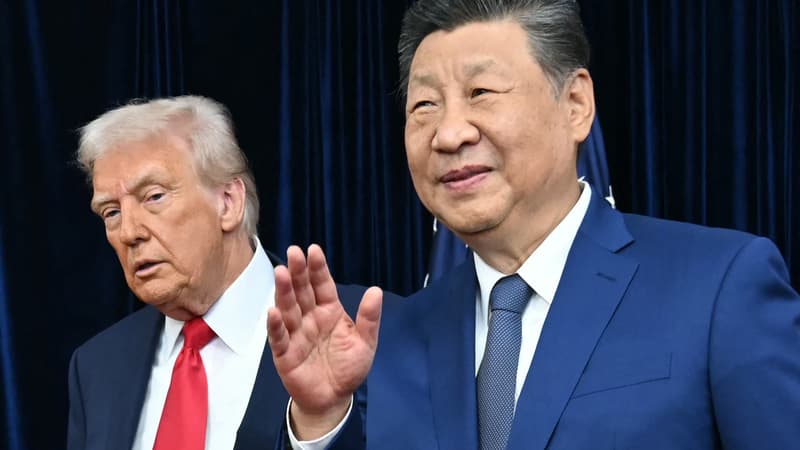Donald Trump left his meeting with Xi Jinping ecstatic this Thursday, October 30, in Busan, South Korea. The American president called it a “great success.” “On a scale of 0 to 10, with 10 being the best score, I would say the meeting was a success at a 12,” he told reporters on the plane taking him back to the United States.
The Head of State announced, in particular, that he had “resolved” the conflict over the supply of rare earths, an essential material over which China exercises a virtual monopoly and whose restrictions imposed by Beijing on its deliveries had provoked his anger. “The agreement on rare earths is already closed and is valid for everyone,” he said. China confirmed this agreement, but in more precise and less inflammatory terms.
At this point, the latter clarified that the suspension applied to the latest restrictions from October 9, but did not mention the previous restrictions, as the New York Times points out. However, Beijing began limiting its rare earth exports in April. Foreign sales of six types of rare earths and the magnets that contained them were then limited. This caused shortages in foreign factories, particularly in Europe.
“As if we were capitulating”
Above all, this suspension seems more like a respite than a lasting appeasement of China’s claims to establish its influence in the world economy thanks to its control of rare earths and, in particular, magnets produced from these elements.
Rather, it appears to constitute a truce in what specialists call “the militarization of trade relations.” In this context, the United States also applies restrictions to certain semiconductors, its strategic product. Washington, for example, prohibits the export of Nvidia’s most advanced chips to China.
On the eve of this summit, Nicholas Kristof estimated in the New York Times that a “suspension for a year of restrictions on the export of rare earths would be a brilliant move by Xi Jinping.”
American columnist Nicholas Kristof added that “at first glance, this might seem like a return to the pre-trade war status quo, but it is more like we are capitulating and finding ourselves in a weak position after a conflict that we ourselves initiated.”
The EU is not out of the woods
Although he could also get a pardon, the European Union is not out of the woods. At the end of last week, Stéphane Séjourné, European Commissioner responsible for Industry, indicated to Le Monde that the supply chains of the Old Continent could “paralyze in two or three weeks”, that is, in mid-November, due to the restrictions imposed by China on October 9. In other words, due to the lack of sufficient stocks, the European industry hardly seems to be able to “last” more than a month if it is deprived of processed rare earths. in China.
To increase this dependence, Beijing even decided in early October to restrict the export of machines and technical information that could allow foreign countries to develop their own rare earth processing capabilities.
Among the very aggressive measures foreseen in the suspended plan, the Chinese authorities also planned to ban the trade of magnets produced abroad if they contained Chinese rare earths, even in minute proportions. The latest regulations also require manufacturers, especially German ones, to provide strategic data.
The other threat to European industry
European industry also continues to face another imminent danger. Many production lines, especially in the automotive industry, risk being disrupted in the coming days due to a lack of semiconductors produced by Nexperia. The Netherlands has decided to take control of this company, based in Nijmegen, which had been bought by Chinese actors in 2018.
In response, Beijing decided to ban the export of components manufactured by Nexperia’s Chinese subsidiaries. The concern is particularly acute in slow-growth Germany, where Volkswagen has approached the government to anticipate partial unemployment for tens of thousands of employees, according to the Süddeutsche Zeitung.
On Wednesday, the European Commission indicated “being in contact” with China and the Netherlands to find “urgent solutions.” According to Le Monde, Emmanuel Macron is pressuring his partners to activate the anti-coercion tool, which the latter had renounced during the negotiation of customs duties with Donald Trump.
The EU trapped in a vice
As the dust settles, the EU finds itself increasingly locked in a two-front trade war. It now risks having to make painful concessions to Beijing, for example by reducing customs duties applied to electric cars produced in China, the negative effect of which for Chinese manufacturers already seems significantly attenuated by the weakness of the yuan against the euro, while imports from the Middle Kingdom have already peaked. Chinese manufacturers have a 7.4% market share in Europe.
At the current rate of progress of Chinese manufacturers, this situation risks happening well before 2030 and will destroy tens of thousands of jobs on European soil, especially as China imports fewer and fewer cars (and products in general) made in Europe.
On the other front of the trade war, the European Union accepted an unfavorable trade agreement with the United States in July, after Donald Trump decided to unleash a trade war justified by American deindustrialization. While he initially targeted Chinese competition, the American president has taken on most of the world’s countries, including his European allies.
This Thursday, October 30, in addition to the agreement on rare earths, it would have only been able to obtain from its main competitor a promise from Xi Jinping to fight against fentanyl trafficking and a commitment from the latter to buy more soybeans, while the Chinese boycott of this agricultural product, triggered in reaction to its customs duties, threatens American farmers with bankruptcy.
Source: BFM TV


